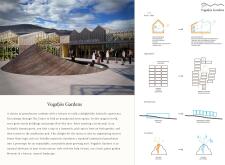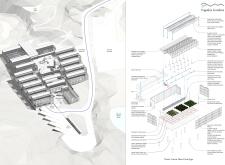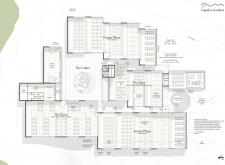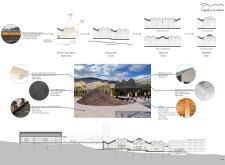5 key facts about this project
The layout of Vogáfjós Gardens consists of several distinct areas, including a central gathering space known as "The Crater," surrounded by modular greenhouse units. This configuration promotes social interaction and serves as a versatile area for activities such as workshops and community gatherings. Additionally, the project includes a teaching kitchen, which emphasizes the importance of sustainable practices in food production. The incorporation of spaces designed for meditation and relaxation further enhances the user experience, allowing for moments of reprieve amidst the dynamic environment.
Unique Design Approaches
One of the distinguishing features of Vogáfjós Gardens is its thematic alignment with Iceland's volcanic landscape. The central "Crater" initiates the narrative of natural growth and communal engagement, serving as a visual and functional heart of the project. The design encourages visitors to flow between the varied spaces, reinforcing a strong connection to the surrounding environment.
The choice of materials is another critical aspect of its design approach. Acoya wood framing provides durability, while Shou Sugi Ban siding offers both aesthetic appeal and resilience against Iceland's weather conditions. Additionally, Kebony wood decking creates a sustainable and attractive surface that withstands heavy foot traffic. The use of bio-polycarbonate glazing in the greenhouse structures maximizes natural light while maintaining insulation, thus ensuring optimal conditions for plant growth.
Integration of renewable energy strategies is evident throughout the project. Passive solar design principles are utilized to enhance energy efficiency, allowing for natural heating and ventilation. The project harnesses Iceland’s geothermal resources, reinforcing its commitment to sustainability and reducing reliance on conventional energy sources.
Community Engagement and Education
The educational aspects of Vogáfjós Gardens are integrated into its design philosophy. The teaching kitchen serves as a focal point for programs centered on sustainable cooking and gardening practices, fostering a culture of environmental stewardship among community members. The design not only highlights the importance of local food sources but also provides practical skills for sustainable living.
For those interested in a detailed exploration of this innovative project, visit the project presentation for additional insights into the architectural plans, architectural sections, and architectural designs that underpin Vogáfjós Gardens. This architectural endeavor embodies a commitment to sustainability and community engagement, making it a significant addition to contemporary architectural practice.


























